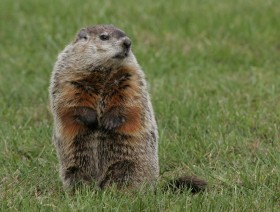THE COLLINS LEARNING CENTER IS CLOSED DUE TO THE WEATHER
We will not be celebrating Groundhog’s Day at Crossroads at Big Creek. It just seems wrong to dedicate a special day to a rodent. These creatures simply are not reliable predictors of weather. Consider last February. Did groundhogs predict that we would have summer temperatures in March? and winter in April? I think not.
So, if groundhogs can’t predict weather—and they can’t, what about other animals? For example, there is popular belief that mammals grow an extra-heavy coats in preparation for a particularly harsh winter. The idea seemed seems somewhat plausible, so I talked to some people who worked at a zoo.
When I asked one gentleman if animals grew thick fur before a bad winter, he brayed rather like one of his charges. ” Oh, how I wish it were true!” he said. ” Do you have any idea how much commodity buyers, resorts and highway departments would give to have that kind of information?
“Seriously,” he continued, “In zoos all over the country, they’ve measured animal fur for years, and have been unable to find any correlation between shagginess and future weather.”
Does that mean animals can’t predict weather? Not exactly.
In an article in National Wildlife Magazine, an atmospheric physicist at the University of Minnesota, George Freier is quoted saying, “If you know some proverbs and some meteorology, you can do a pretty good job of making forecasts.”
He gave the example of a proverb: When spiders spin their webs by noon, fine weather is coming soon.
True. When humidity is high, the silk absorbs water, shortens, and snaps, forcing spiders to make repairs throughout the day. In fair weather, the silk is easier to weave so spiders finish before noon.
Birds have long been credited with the ability to predict weather. It’s too bad they can’t. Every spring and fall, millions of migrating birds perish in hurricanes, ice storms, and frigid temperatures.
On the other hand, birds are very aware of barometric pressure and wind direction. Birds often migrate in a high-pressure front, flying at considerable altitudes. In a low-pressure cell, they fly close to the ground or just wait out the bad weather on the ground. Knowing this, a careful observer can make accurate forecast.
Actually, anyone who spends time with animals know they can sense a change in weather. Maybe it’s the pressure, or perhaps they hear distant thunder before we do, but animals get downright spooky before a storm. So animals can sort of predict short term weather trends.
Six weeks out? Only if they see a shadow on February 2.
Farmers tend to be concerned about the weather. But whatever the weather, most farmers believe that they live ” a rich life.” A Rich Life, The History of Door County Dairy Farming will be screened on Wednesday, January 30 at 2:00 in the lecture hall of the Collins Learning Center. History programs are free and open to the public.
Those interested in astronomy are invited to join the Door Peninsula Astronomical Society held at the Stonecipher Astronomy Center at Crossroads’ Astronomy Center. The meetings are held the first Tuesday of each month at 7:00.
January 30, 2:00 History Video: A Rich Life.
This video documentary tells the story of the dairy industry of Door County. Once there were 1,300 dairy farms. Today there are fewer than 150.Once there were 49 cheese factories. Today there is one.This is the story of a life’s labor that has virtually disappeared.Free and open to the public
Sunday, February 3, 1:30-3:30 Family Ski Friends of Crossroads invite the public to get in touch with nature through winter recreation. Visitors may borrow skis/ bindings or snowshoes free of charge. They must be used on the Crossroads property and returned before dark. Equipment is in the lower level of the Collins Learning Center
Tuesday, February 5, 7:00 Meeting of the Door Peninsula Astronomical Society
DPAS invites the public to the February General Meeting . The video “Europe to the Stars” will be screened and the lecture “New Moon Formation Theories will be offered by Professor Ray Stonecipher. Meet in the Stonecipher Astronomy Center. Please use the Utah Street Entrance. Refreshments. Free and open to the public.

